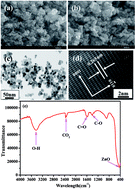Zinc oxide quantum dots: multifunctional candidates for arresting C2C12 cancer cells and their role towards caspase 3 and 7 genes†
Abstract
Recently, nanoscale (<100 nm) inorganic materials, especially spherical shaped zinc oxide quantum dots (ZnO-QDs), have received a lot of attention from the broad community because of their potential utilization in various technologies. Due to their large surface to volume (S/V) ratios and extremely high reactivities, they can easily penetrate in various biological identities, such as cells and proteins, and therefore can sense, diagnose and cure different biological systems. The present study describes the facile synthesis of crystalline ZnO-QDs via a solution process. In addition, C2C12 myoblast cancer cells have been treated with different doses of ZnO-QDs at different incubation times (24, 48, 72 and 96 h). The rate of inhibition of cells was observed using an MTT assay, whereas the morphology of the cells was observed by confocal microscopy (CLSM). The MTT and CLSM investigations confirmed that with an increase in the incubation time, the population density of cancer cells was decreased when treated with ZnO-QDs. The dose dependent apoptosis correlated with intracellular production of reactive oxygen species (ROS) from C2C12 cancer cells was also measured in presence of ZnO-QDs. Moreover, the effect/apoptosis of these QDs was also checked in the presence of candidate genes such as caspase 3/7 with GAPDH. Reverse transcription polymerase chain reaction (RT-PCR) analysis demonstrates the up-regulation of caspase 3/7 genes in cells subsequently treated with ZnO-QDs at low and high concentrations.

- This article is part of the themed collection: Editors Collection for RSC Advances - India

 Please wait while we load your content...
Please wait while we load your content...